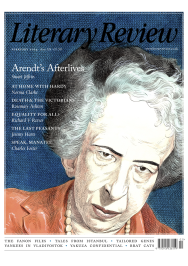Rosemary Ashton
Crape Expectations
Rites of Passage: Death and Mourning in Victorian Britain
By Judith Flanders
Picador 336pp £25
Judith Flanders has undertaken a mammoth task. The Victorian period is widely known for its excessive, sometimes scarcely believable interest in death and everything that surrounds it. There are so many set pieces involving death in the fiction of the era, particularly the scenes of children dying in Dickens’s writings. The demise of Little Nell in The Old Curiosity Shop notoriously caused grown men to weep on both sides of the Atlantic when the book was serialised in 1840–41. The protracted dying of poor Jo the crossing-sweeper in Bleak House (1852–3) shows Dickens putting sentiment surrounding the death of a child to good use in the cause of political and social criticism. The narrator sums up the terrible life and death of this destitute child, one of so many ‘dying thus around us every day’. And who is being addressed here? ‘Dead, your Majesty. Dead, my lords and gentlemen. Dead, Right Reverends and Wrong Reverends of every order.’ Thus far, a modern reader is likely to be wholly on Dickens’s side as he lambasts those in authority for doing nothing for the poor. But, as Flanders points out in one of many sharp literary critical insights in her book, the

Sign Up to our newsletter
Receive free articles, highlights from the archive, news, details of prizes, and much more.@Lit_Review
Follow Literary Review on Twitter
Twitter Feed
It wasn’t until 1825 that Pepys’s diary became available for the first time. How it was eventually decrypted and published is a story of subterfuge and duplicity.
Kate Loveman tells the tale.
Kate Loveman - Publishing Pepys
Kate Loveman: Publishing Pepys
literaryreview.co.uk
Arthur Christopher Benson was a pillar of the Edwardian establishment. He was supremely well connected. As his newly published diaries reveal, he was also riotously indiscreet.
Piers Brendon compares Benson’s journals to others from the 20th century.
Piers Brendon - Land of Dopes & Tories
Piers Brendon: Land of Dopes & Tories - The Benson Diaries: Selections from the Diary of Arthur Christopher Benson by Eamon Duffy & Ronald Hyam (edd)
literaryreview.co.uk
Of the siblings Gwen and Augustus John, it is Augustus who has commanded most attention from collectors and connoisseurs.
Was he really the finer artist, asks Tanya Harrod, or is it time Gwen emerged from her brother’s shadow?
Tanya Harrod - Cut from the Same Canvas
Tanya Harrod: Cut from the Same Canvas - Artists, Siblings, Visionaries: The Lives and Loves of Gwen and Augustus John by Judith Mackrell
literaryreview.co.uk